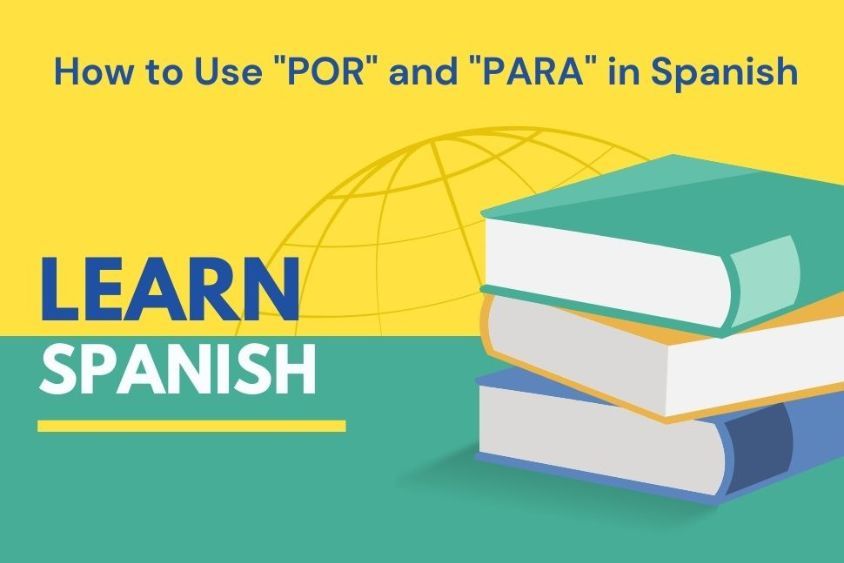Learn Spanish
How to Use "POR" and "PARA" in Spanish
Dec 09, 2023
|
0
Hey there, language enthusiast! If you're diving into the beautiful world of Spanish, you've probably encountered the two tricky words "por" and "para." These tiny words might seem unassuming, but they're crucial for mastering the language. In this article, we'll break down the usage of "por" and "para".
IN THE ARTICLE:
What's the Deal with "POR"?
Cracking the Code of "PARA"
A Little Help from a Familiar Face
Why a Personal Tutor Is a Game-Changer
Colloquial Expressions: "Por" and "Para" in Action
Mastering "POR" and "PARA" for Fluent Spanish Communication
What's the Deal with "POR"?
Let's kick things off with "por." It's like the chameleon of Spanish prepositions; it can do a little bit of everything. Here are some common scenarios:
- Causation: Picture this – you stayed up all night watching your favorite telenovela for pure excitement. In Spanish, it would be: "Quedarse hasta tarde viendo tu telenovela favorita por pura emoción”. "Por" here indicates the cause behind your sleepless night.
- Duration or time: If you're planning a beach day in the afternoon, in Spanish it would be: "Planeo un día en la playa por la tarde”.
- Means or method: Imagine you're a music enthusiast and want to tell someone how you enjoyed an exhilarating concert. You can say: "Disfruté del concierto de rock por la increíble energía de la banda”.
- Exchange or substitution: If you trade your vintage vinyl collection "por un ordenador nuevo”, you're swapping one thing for another.
- Through or along: You could take a leisurely walk "por las bonitas calles de Barcelona”. It's all about moving through or along a place.
Cracking the Code of "PARA"
Now, let's unravel the mysteries of "para". It's all about destination and purpose. Check this out:
- Destination: If you say, "Estoy saliendo para la tienda," it means you're heading to the store.
- Purpose: "Estudio español para hablar con mis amigos" – here, "para" signifies that you're studying Spanish with the purpose of chatting with your pals.
- Deadline or time limit: If your Spanish teacher assigns homework "para mañana”, you better finish it by tomorrow.
- Comparison: "Para mí, el último disco de Bad Bunny es el mejor”. "Para" here is used to express a personal preference.
A Little Help from a Familiar Face
Let's call in a familiar friend – the globally renowned singer, Shakira. You see, even she relies on "por" and "para" to express herself in her songs. When she sings "Por ti seré gaviota de tu bella mar," she's using "por" to express dedication and the cause of her actions. And when she says, "Para amarte necesito una razón," she's referring to the purpose or motive – she needs a reason to love.
Why a Personal Tutor Is a Game-Changer
Learning "por" and "para" can be as tricky as deciphering the latest slang in a hip-hop track. But fret not; a personal tutor is your secret weapon. They'll help you navigate the maze of these prepositions, correct your mistakes, and provide real-world examples.
Imagine you're chatting with your tutor, and they tell you, "Estás estudiando español "para" comunicarte mejor con tus amigos latinos." In this instance, they're using "para" to highlight the purpose of your Spanish studies. You get instant feedback, answers to your burning questions, and the confidence to tackle Spanish conversations like a pro.
If you are interested in learning Spanish in an effective way with the help of a private tutor, you are in the right place. Click on the following link for more information.
Colloquial Expressions: "Por" and "Para" in Action
Here are some examples of everyday conversations with "por" and "para" to see how they work in context with the guidance of a tutor:
Friend A: "¿Por qué no vienes a mi fiesta esta noche?"
Friend B: "Lo siento, no puedo. Tengo que estudiar "para" un examen importante."
Friend A: "¿Tienes tiempo "para" un café?"
Friend B: "¡Claro! Estoy "por" aquí cerca, así que nos encontramos en el café del centro.
Friend A: "¿Has comprado un regalo "para" tu hermano?"
Friend B: "Sí, compré un libro "para" él.
Friend A: "¿Por qué te despertaste tan temprano?"
Friend B: "Fue "por" el ruido de la construcción que comenzó a las 6 a. m.
Mastering "POR" and "PARA" for Fluent Spanish Communication
In the exciting journey of learning Spanish, understanding the differences between "por" and "para" is an important step. These seemingly small words have a big impact on your ability to express yourself accurately in the language.
Remember, "por" is the versatile chameleon that can represent causation, time, means, exchange, or movement. It helps you connect the dots in your conversations and add depth to your expressions. On the other hand, "para" focuses on destination and purpose. It helps you convey your intentions, deadlines, or personal preferences, clarifying your communication.
So, whether you're planning a beach day "por la tarde" or studying "para" pass the exam, mastering "por" and "para" is your ticket to speaking Spanish like a pro. Enjoy the journey, and remember that practice makes perfect. ¡Buena suerte!





